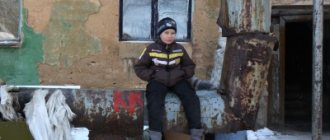Signs of housing disrepair
Residential premises are classified as emergency and unsuitable for living under the following conditions:
- the supporting and enclosing structure is deformed or damaged;
- Part of the utilities (electricity, water supply) does not work or is missing;
- apartment ventilation that has become unusable mixes air flows from living rooms, kitchen and bathroom;
- Toxic substances were identified in the apartment;
- the temperature in the premises does not exceed 18 degrees;
- humidity exceeds 60%;
- living rooms are located in the basement or basement;
- there are no windows in the rooms;
- there is no insolation that meets the standards.
Is not unsuitable:
- low-rise building without hot water supply and sewerage systems;
- a building without an elevator above the fifth floor unless it is completely in use;
- an object with discrepancies in the planned and actual areas of residential premises.
Signs of emergency are not the same as grounds for declaring a residential building unfit for habitation. Before considering the algorithm for recognizing a house as unsafe or dilapidated, you need to check the Decree of the Government of the Russian Federation of January 28, 2006 No. 47.
The government promises to solve the problem of dilapidated housing
The volume of emergency housing continues to increase. Photo by RIA Novosti
Russian authorities now hope to speed up the resettlement of dilapidated and dilapidated housing. At least, such plans are voiced by Russian Prime Minister Mikhail Mishustin. The problem of resettlement from emergency housing stock has not been solved for decades, which is confirmed by the growing area of such housing. To reverse this trend, the country needs to double construction volumes. New incentives are also needed for regional officials, who must resettle dilapidated housing and maintain the existing housing stock so that it does not replenish emergency areas, experts point out.
“The President set the task of accelerating such work (on resettlement from dilapidated housing - NG) and ensuring the rapid achievement of goals for the resettlement of dilapidated apartment buildings,” the prime minister said on Wednesday at a meeting of the Cabinet of Ministers. He also emphasized that all measures necessary for this, both financial and regulatory, will be taken into account when forming the budget for 2021.
In particular, Deputy Prime Minister Marat Khusnullin explained that the authorities intend to speed up the resettlement of dilapidated housing through a special bill that will be submitted to the State Duma in the autumn session. “We have a program for the resettlement of emergency and dilapidated housing. We are now looking at how to speed it up so that it ends not in 2024, but in 2023. And since the volume of this housing is quite large across the country, we are now preparing proposals; in the autumn session we will introduce certain bills to the State Duma to speed up this program,” said the Deputy Prime Minister. “In order to speed up the program for the demolition of this housing, we have prepared amendments to Federal Law 185, these amendments will be adopted in the fall. Within the limits that are defined for the constituent entities of the Russian Federation until 2024, it will be possible to select funds earlier,” said the head of the Ministry of Construction, Vladimir Yakushev.
At the beginning of June, the government presented to the president a national economic recovery plan, which included the accelerated implementation of the federal project “Ensuring a sustainable reduction of uninhabitable housing stock” (included in the national project) using funds for 2023–2024, including establishing the possibility of using credit mechanisms and interest rate subsidies. This project, in particular, assumes that by the end of 2024 the volume of resettled emergency housing should reach 9.54 million square meters. m, and the number of citizens resettled from it is 530.9 thousand. The total amount of financing for the implementation of the federal resettlement project from all sources will be 507.2 billion rubles. until the end of 2024.
Today's statements by officials are actually a repetition of last year's plans. Thus, the Ministry of Construction announced that “in the period 2019–2024, 531 thousand people who live in emergency housing will be resettled, 9.5 million square meters. m". That is, now they want to “compact” these goals until 2023. At the same time, the stated goals of the officials “did not conflict” with their own goals of putting new housing into operation (see “NG” dated February 21, 2019).
Economists from the Center for Macroeconomic Analysis and Short-Term Forecasting estimated that by 2025, the accumulated volume of disposal of dilapidated and dilapidated apartment buildings will amount to more than 80 million square meters. m, and by 2035 it will reach almost 191 million sq. m. True, only if about 90 million square meters are introduced. m of housing annually (see “NG” dated 10/09/19).
The bill announced by Khusnullin and Yakushev to speed up the resettlement of emergency housing is not the only one. Previously, it was also proposed to solve the problem of resettlement from emergency housing through the purchase by the state of unclaimed, unsold real estate (see “NG” dated June 16, 2020).
At the same time, the authorities report on “an accelerated pace of resettlement of emergency housing.” “Since last year, more than 1.3 million square meters have already been resettled. m of emergency housing, living conditions were improved for more than 85 thousand people. The pace is good, 34 regions have fully achieved target indicators this year,” Mikhail Mishustin emphasized on Wednesday. Vladimir Yakushev previously reported that as of June 1, 2020, 1.074 million square meters have already been resettled in Russia. m (+7.43% to plan) and more than 66 thousand people (+21.6%). At the same time, at the end of 2020 alone, about 30 thousand Russians moved out of dilapidated houses, and the dilapidated housing stock itself decreased by 527 thousand square meters. m, the minister said. The head of the Ministry of Construction emphasized: the federal project for the resettlement of emergency housing has become one of the most effective in the past year, exceeding the 2020 targets by almost four times.
Indeed, there is a certain acceleration in work to resettle residents from dilapidated and dilapidated housing. Thus, on the website of the Fund for Assistance to the Reform of Housing and Communal Services (HCS) “Housing and Communal Services Reform” it is reported that from 2008 to 2013 over 5.19 million square meters were resettled. m of emergency housing, that is, approximately 1 million sq. m annually. Moreover, from 2014 to 2020, 10.8 million square meters were already resettled. m, or 2.16 million annually.
However, despite the acceleration, the remaining volumes for resettlement are impressive. As follows from the data on the Housing and Communal Services Reform website, there are currently over 72 thousand emergency houses with a total area of 19.24 million square meters “registered” for resettlement. m, and 1.13 million people are waiting in line for resettlement.
And this despite the fact that the volume of dilapidated and dilapidated housing tends to increase. Thus, the number of emergency apartment buildings in the Russian Federation increased from 2014 to 2020 by 24.5%, and the volume of housing stock, which has depreciation from 66 to 70% and above, not only does not decrease, but even tends to increase, the Accounting Office said ward (see “NG” dated 05.11.19). For comparison: in 2020, the volume of emergency housing stock in the Russian Federation was 19.6 million square meters. m, or 0.5% of the total housing stock in the country, but already in 2018 – 25.5 million sq. m. m, or 0.7% of the total housing stock, follows from Rosstat data.
The main problem with the resettlement of such housing is the slow pace of new construction. “Only in the mid-2010s did Russia reach the volume of construction of the late Soviet period of the RSFSR (about 80 million square meters of housing). But in modern conditions this is not enough,” says managing partner Maria Litinetskaya. The commissioning of new housing does not directly affect the situation with dilapidated and dilapidated housing, since residents of dilapidated houses, as a rule, belong to the poorest segments of the population who cannot afford to buy new apartments. “New square meters are circulating among citizens with average and high incomes, while the square meters of the bulk of the population continue to age,” she explains, noting that to solve this problem, the pace of construction must be twice as high.
Another reason for the deterioration of housing is the low cost of major repairs and poor maintenance of the housing stock in the 1990s - zero years, Litinetskaya points out. “The annual volume of capitally renovated premises in the 1990–2010s compared to the 1970–1980s decreased by 2–3 times. Because of this, the deterioration of the housing stock has accelerated. If in 1990 in Russia there were 3.3 million emergency square meters, then by 2020 their number increased to 25 million. The disposal of huge blocks of housing built in Soviet times begins (Khrushchev buildings of the 1950–1970s, which make up 36% of residential area),” explains the expert. Thus, in the historically foreseeable period, the same process will begin with the housing stock of the 1970s - mid-1990s, that is, without drastic measures, the problem will only become more acute, she summarizes.
In addition, says Vladimir Shchekin, co-owner of the Rodina group, the burden of solving resettlement problems has largely been shifted to regional authorities, who do not have the money for this. “Moreover, they have an interest in understating the real volume of dilapidated and dilapidated housing, which is probably greater than the official data of Rosstat. The authorities are trying to develop resettlement mechanisms that require investments from residents of dilapidated and dilapidated buildings, but they practically do not work due to the fact that the owners of apartments in such housing have no money,” he emphasizes.
Reasons to recognize a house as unfit for habitation
Rights of Residents
After housing is recognized as unsafe and subject to resettlement and demolition, residents have the right to receive in return similar housing, equivalent in size and amenities. Read about the provision of housing to replace emergency housing in the article https://realtyinfo.online/5125-usloviya-poryadok-pereseleniya-lyudei-iz-avariinogo-zhilya-v-year-godu.
According to paragraph 33 of the Regulations approved by the said resolution, recognition of housing as unfit for habitation is feasible if:
- the house cannot be restored after an explosion, fire, or natural disaster;
- the building is at risk of destruction in the event of a man-made accident, the probability of which is high due to the increasing frequency of natural disasters;
- the house is located in an area with a high risk of avalanches, mudflows, landslides, and floods;
- the foundation or structural elements of the building are deformed;
- the house is located next to a source of noise exceeding the permissible limit of 55 decibels;
- there is a power line or structure for transmitting alternating current close to the house;
- in a specially designated area next to the building, waste chutes are washed and cleaned;
- the house does not meet hygienic requirements and sanitary and epidemiological standards.
Housing with a degree of wear of at least 70% for stone houses or 65% for structures made of wood or local materials, as well as attics, is also considered unsuitable.
A building is considered subject to demolition if it is technically impossible or economically infeasible to solve the problem under the law on major repairs 271-FZ through major repairs or reconstruction.
Recognition of housing as unsuitable
A residential property is declared unsuitable for citizens to live in by a specially formed commission.
A home inspection is carried out by independent specialists, based on the results of which a corresponding report is drawn up. Based on the independent examination report, the interdepartmental commission makes a decision on the unsuitability of the house.
If the house is assigned the status of emergency housing and subsequent operation is impossible, the residents must be relocated to other residential premises or they are provided with compensation in cash (in relation to citizen-owners of apartments).
A house is considered unsafe in the following cases:
| There is significant damage to the load-bearing and enclosing structures of the building | which pose a threat of its collapse |
| Placing a building in an area of constant flooding | as a result of rising groundwater levels, heavy rains or melting snow |
| Deterioration of strength as a result of natural disasters | or man-made accidents |
| Failure to comply with sanitary standards without the possibility of their restoration | and other cases established by legislative acts |
Who is eligible
Residents living in a house recognized as unsafe by an interdepartmental commission have the right to be resettled in new comfortable housing. To assign such a status to a property, the year of construction is not enough; its technical condition, degree of wear, presence of deformations, condition of engineering systems, etc. matter.
Residential buildings that are unsuitable for habitation are subject to inclusion in the list of houses for demolition.
If the building is included in such a list, then the residents have the right to be provided with new living space in a short time.
Not only citizens who own the premises, but also tenants under a social tenancy agreement can get a new apartment.
Cash compensation for the purchase of housing is only available to owners of emergency apartments.
It is necessary to distinguish between two types of home condition - emergency and dilapidated housing. Their difference lies in the degree of wear and tear of the houses. This indicator influences the decision of the interdepartmental commission, as well as the timing of resettlement.
A building is considered dilapidated if it has a degree of wear of 65 percent or more (wooden houses) and 70 percent (concrete buildings). These objects are not demolished, but are being repaired or reconstructed.
Relocation is subject to certain circumstances:
| The land plot is seized for public needs | for a specific purpose (for example, for the construction of a social facility) |
| Housing included in the list for demolition | to renew public housing stock |
| Construction of a larger and more significant facility for the city | and the old building should be demolished |
In the above cases, demolition of objects is carried out within the time limits established by law.
Citizens are provided with alternative housing that meets the requirements for comfortable residential premises.
Unsafe buildings must be demolished. These include houses if more than 50 percent of the living space in them cannot be repaired, and the presence of residents in such houses poses a threat to their life and health.
In particular, significant deformations of load-bearing walls, which pose a real threat of collapse of the property.
If it is impossible to carry out major repairs, dilapidated houses must be demolished, regardless of the degree of deterioration of the building as a whole.
Buildings unsuitable for habitation are:
| Houses subject to demolition or reconstruction | buildings in an area where sanitary standards are not met |
| Buildings located in areas prone to natural disasters | if it is not possible to prevent the influence of unfavorable factors on the construction |
| Objects damaged in natural disasters | and refurbishment of the house is impractical |
| Houses with high noise levels | which exceeds the permissible limits |
Houses not subject to relocation:
| Objects | with more than 5 storeys and in the absence of an elevator or in the absence of water supply or sewerage |
| Facilities with minor violations of current standards | if possible, install additional equipment, etc. |
Appointment of technical expertise
To give a house the status of unsuitable housing, it is necessary to submit an independent expert report on its condition to a specially created commission.
Such a conclusion about the condition of the housing is the primary document in order to begin the relocation procedure.
The appointment of an examination can be requested either by supervisory institutions (Housing Inspectorate) or directly by the residents of the dilapidated house themselves.
In some cases, other institutions may initiate the resettlement procedure (for example, Rospotrebnadzor authorities, administration, prosecutor’s office, etc.)
For rules of resettlement from municipal housing, see the article: rules for resettlement during demolition of a house.
To perform the examination, it is necessary to involve the following specialists:
- design engineers;
- SES employees;
- fire authorities, etc.
An independent examination is carried out to examine the condition of the housing and to examine the possibility of using the house.
If there are significant deformations of a property, it is considered unsafe and is subject to demolition and resettlement.
Legislative regulation
The procedure and conditions for relocating residents from emergency buildings are based on the provisions of the current housing legislation.
Regulatory framework for the resettlement process:
| The most important standards are established in the Federal Law “On the Fund for Assistance to the Reform of Housing and Communal Services” dated July 21, 2007. | at the regional level, special programs are being adopted for the resettlement of residents of dilapidated houses and major repairs of dilapidated housing |
| Provisions of Art. 89 Housing Code of the Russian Federation | establishes the right to receive a new apartment to replace the old living space in a building unsuitable for habitation |
| Art. 32 Residential Complex of the Russian Federation | establishes the possibility of issuing monetary compensation in relation to the owners (if there is other housing) |
| Council housing tenants | By virtue of Art. 86 of the Housing Code of the Russian Federation, have the right to new housing of equal value (same area, with the same number of rooms, with the same decoration) |
| In the instructions of Art. 57 Housing Code | the principle of priority for the provision of premises to residents based on the time of their registration has been established |
Procedure: we seek recognition of the house as unsafe
Now let’s look at how to recognize a house as dilapidated or unsafe, step by step:
- Draw up an application and submit it to the municipal authority;
- Collect documents;
- Order an examination to recognize a building as unsafe from an organization with a license to conduct it;
- Take part in the work of the commission to recognize the house as unsafe;
- At the end of the commission’s work, make a request to the municipality whether the house is recognized as subject to demolition or not.
Please note: if a residential building is an architectural monument, it will not be subject to demolition, no matter how unsuitable its condition may be. For an apartment owner who expects to get another housing, the procedure for recognizing a house as unsafe in this case is useless.
The law distinguishes between architectural monuments of federal, regional and local significance. To find out if your home is one of them, you need to make a written request to your local architecture department.
If it does, the maximum you will achieve is a conclusion about the need for repair or restoration of the building. Please note that the examination to recognize an architectural monument as unsafe is carried out only by an organization with a separate license and is more expensive.
Important: at the beginning of the process, try to agree with the owners of other apartments to share the costs of the examination. Residents of an apartment building also have the right to submit a collective application to recognize the building as unsafe.
Composition of the interdepartmental commission for recognizing housing as unsafe
Housing that is in dilapidated and disrepair is within the competence of the established interdepartmental commission. She thoroughly studies the situation for each building and makes a decision on the suitability of the house for citizens to live in.
Each city, district or other locality has its own commission composition. It is approved by the administration at the appropriate level.
Representatives of the following departments, bodies and organizations can become members of the commission:
- Administration of a rural settlement or city;
- Department of Architecture and Urban Planning;
- Deputies;
- Bodies exercising supervisory functions;
- Ministry of Emergency Situations;
- BTI;
- Rospotrebnadzor;
- Chairmen of the self-government body of the house or management company.
The commission is created on the basis of a decision of local government bodies. They also determine its composition.
Composition of the interdepartmental commission
Someone from the local executive authority is appointed as the chairman of the commission.
He has the following responsibilities:
- Conducting a committee meeting;
- Distributes instructions to its members, focusing on their competence in solving a specific range of issues;
- Representative function;
- Signing official documents, including protocols, decisions, etc.
Another position on the commission is secretary. He prepares papers, fills out minutes of commission meetings and receives applications from citizens.
The activities of the body should not contradict the Constitution of the country, the Housing Code of the Russian Federation, PP No. 47 and other current legal acts.
Resettlement of owners from emergency housing in 2020.
How to find out if a house is recognized as unsafe, read here.
Read about the procedure for recognizing a house as unsafe and subject to demolition at the following link:
Who checks the suitability of the house
Having registered an application, municipal authorities are obliged to transfer it to the permanent interdepartmental commission for recognizing housing as unsafe or to create a commission specifically to inspect your house.
The interdepartmental commission includes:
- representatives of regional and municipal authorities;
- design engineers;
- representatives of Rospotrebnadzor, sanitary-epidemiological, fire and other services;
- owners or tenants of housing.
It is recommended to join the commission or at least closely observe how officials recognize housing as dilapidated and unsafe in order to help them draw the right conclusions.
The period for consideration of the application does not exceed 30 days, and in special cases is reduced to 1 day.
How to recognize a house as dilapidated and subject to demolition
Housing is recognized as dilapidated or generally unsuitable for living in it in accordance with the procedure established by housing legislation. The owner of a dilapidated residential building has every right, on his own initiative, to submit an application to the relevant authorities for an inspection and recognition of his house as unfit for living.
Where to go
To recognize housing as dilapidated, you must contact the Department of Housing Policy, the regional housing inspectorate or any other authorized body and fill out an application. It is sent to a special interdepartmental commission to assess the compliance of the house with the requirements established by the legislative acts of the Russian Federation, which will evaluate the actual condition of the structure, observing all requirements and standards, and draw up an official conclusion. The commission includes representatives of Rospotrebnadzor, the Ministry of Emergency Situations, local administration, housing inspection and other departments that may be involved in this case one way or another.
The application is drawn up in free form and written by hand, after which it is sent by mail to the commission in the form of a postal letter or, if possible, personally handed over to the responsible authorized person of this commission. But today it is possible to simplify this procedure and compose a letter electronically, sign it with an electronic signature and send it by email or through the Public Services Portal.
What documents are required
Collecting numerous documents is the most difficult stage of the procedure for declaring housing unfit for habitation. Here is the standard list of papers:
- a notarized copy of the title document for the apartment or the social tenancy agreement;
- registration certificate of an apartment building from the BTI;
- expert opinion on the technical condition of housing;
- an act of inspection of the building by the property owner, performed over the last three years, indicating the types and volumes of repair work during this period;
- act of the housing inspection in the subject of the federation on the current condition of the house;
- other documents required by the municipality or interdepartmental commission.
The procedure for recognizing housing as unsafe and issues of relocation from such a house are covered in the following video
How long will the relocation procedure take?
The timing of relocation of emergency housing is determined by the local government, based on the adopted program at the level of a specific region.
Issues related to the process of demolition of houses and relocation of residents are the responsibility of municipal authorities. The timing of the provision of new apartments depends on the decisions they make.
But residents can also influence the timing of the program by challenging the administration's actions in court.
Municipal decisions can be appealed in court if continued living in a dilapidated house poses a danger to the residents.
Residents' actions
To recognize a building as unsafe and begin the relocation procedure, the following actions are performed:
- An independent examination of the condition of the house is carried out;
- Submitting an application and necessary documents to the formed commission;
- Notifying residents of the decision made;
- Adding the property to the list of houses for demolition.
- Actual resettlement of citizens.
The procedure for relocating residents depends on the basis on which the citizen owns the living space. In particular, owners are provided with new housing or monetary compensation.
Tenants are provided with compensation only in kind. At the same time, a new social tenancy agreement is drawn up.
At the legislative level, the requirements for new residential premises are established:
| The footage is no less than that of the old housing | fully landscaped (citizens cannot be evicted into an apartment in a new building that does not have finishing) |
| Equal living conditions | for example, if the living space in a dilapidated building was located on the first 3 floors, then it is prohibited to move them to the top floor without the consent of the residents |
| Location in the same locality | Only with consent is it possible to move to another region |
| The monetary compensation must be no less than the market value of the housing and cover moving costs | expenses for drawing up a purchase and sale agreement, renting temporary housing before purchasing a new apartment, and real estate agency services are also reimbursed |
Often, citizens are forced to go to court to assert their rights to adequate compensation issued in exchange for the housing being resettled.
Municipal authorities are interested in reducing the redemption price of residential premises in a dilapidated building.
Typically, the amount of compensation is established by agreement between residents and administration. If no agreement is reached, the redemption price may be set in court.
What documents are needed
Consideration of applications for the relocation of citizens from emergency buildings is carried out by an interdepartmental commission. Along with the application, the following documents are provided:
| Title documents for residential premises | Extract from the Unified State Register or certificate of state registration of property |
| Technical passport of the apartment | as well as an expert opinion on the technical condition |
Also, complaints from citizens regarding the technical condition of the property may be attached to the application. It is recommended to attach several photographs of damage to structural elements of the house, confirming that it is dangerous to live in it.
The application is considered within 30 days. If necessary, additional expertise may be required to verify the information provided or if there are doubts about the reliability of the information.
After making a decision, the commission notifies residents about it within five days.
If the house poses a real danger to residents, then the review period may be reduced.
Citizens living in emergency housing have the right to appeal the decision through the court. In this case, the process of collecting documents will need to be repeated.
Redemption value
The redemption value is determined by the local administration based on the market price of the residential premises. The purchase price is provided in exchange for the repossessed apartment.
As a rule, local authorities try to reduce the redemption price for an old apartment, arguing that it is in significant disrepair, poor infrastructure development and other reasons.
New program for the resettlement of emergency housing in 2020, see here.
If residents do not agree with the purchase price of housing, they can appeal the decision of local authorities in court, but only within 2 years after the administration’s decision on resettlement is adopted.
Video: Description of the program and period of resettlement from dilapidated and dilapidated housing:
(No Ratings Yet)







